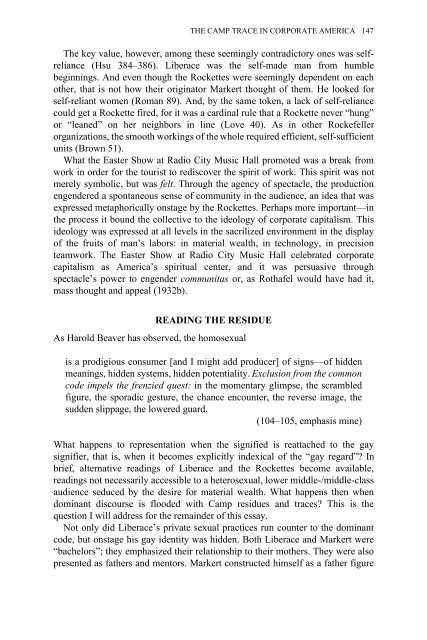Edited by Moe Meyer - Get a Free Blog
Edited by Moe Meyer - Get a Free Blog
Edited by Moe Meyer - Get a Free Blog
Create successful ePaper yourself
Turn your PDF publications into a flip-book with our unique Google optimized e-Paper software.
The key value, however, among these seemingly contradictory ones was selfreliance<br />
(Hsu 384–386). Liberace was the self-made man from humble<br />
beginnings. And even though the Rockettes were seemingly dependent on each<br />
other, that is not how their originator Markert thought of them. He looked for<br />
self-reliant women (Roman 89). And, <strong>by</strong> the same token, a lack of self-reliance<br />
could get a Rockette fired, for it was a cardinal rule that a Rockette never “hung”<br />
or “leaned” on her neighbors in line (Love 40). As in other Rockefeller<br />
organizations, the smooth workings of the whole required efficient, self-sufficient<br />
units (Brown 51).<br />
What the Easter Show at Radio City Music Hall promoted was a break from<br />
work in order for the tourist to rediscover the spirit of work. This spirit was not<br />
merely symbolic, but was felt. Through the agency of spectacle, the production<br />
engendered a spontaneous sense of community in the audience, an idea that was<br />
expressed metaphorically onstage <strong>by</strong> the Rockettes. Perhaps more important—in<br />
the process it bound the collective to the ideology of corporate capitalism. This<br />
ideology was expressed at all levels in the sacrilized environment in the display<br />
of the fruits of man’s labors: in material wealth, in technology, in precision<br />
teamwork. The Easter Show at Radio City Music Hall celebrated corporate<br />
capitalism as America’s spiritual center, and it was persuasive through<br />
spectacle’s power to engender communitas or, as Rothafel would have had it,<br />
mass thought and appeal (1932b).<br />
READING THE RESIDUE<br />
As Harold Beaver has observed, the homosexual<br />
THE CAMP TRACE IN CORPORATE AMERICA 147<br />
is a prodigious consumer [and I might add producer] of signs—of hidden<br />
meanings, hidden systems, hidden potentiality. Exclusion from the common<br />
code impels the frenzied quest: in the momentary glimpse, the scrambled<br />
figure, the sporadic gesture, the chance encounter, the reverse image, the<br />
sudden slippage, the lowered guard.<br />
(104–105, emphasis mine)<br />
What happens to representation when the signified is reattached to the gay<br />
signifier, that is, when it becomes explicitly indexical of the “gay regard”? In<br />
brief, alternative readings of Liberace and the Rockettes become available,<br />
readings not necessarily accessible to a heterosexual, lower middle-/middle-class<br />
audience seduced <strong>by</strong> the desire for material wealth. What happens then when<br />
dominant discourse is flooded with Camp residues and traces? This is the<br />
question I will address for the remainder of this essay.<br />
Not only did Liberace’s private sexual practices run counter to the dominant<br />
code, but onstage his gay identity was hidden. Both Liberace and Markert were<br />
“bachelors”; they emphasized their relationship to their mothers. They were also<br />
presented as fathers and mentors. Markert constructed himself as a father figure


